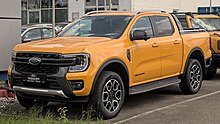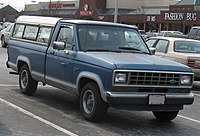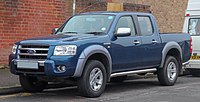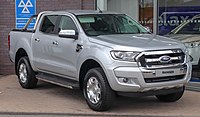| Revision as of 21:30, 1 March 2020 edit2600:1700:210:1450:a96d:1ac1:1c72:3a06 (talk) →Americas (1983–2011, 2019-present)← Previous edit | Latest revision as of 00:20, 24 December 2024 edit undoSqueakachu (talk | contribs)Extended confirmed users, Pending changes reviewers, Rollbackers19,354 editsm Reverted edit by 148.252.133.181 (talk) to last version by Skywatcher68Tag: Rollback | ||
| (132 intermediate revisions by 68 users not shown) | |||
| Line 1: | Line 1: | ||
| {{About||the current generation sold globally|Ford Ranger (T6)|the international version jointly developed with Mazda|Ford Ranger (international)|the North and South American version sold prior to 2011|Ford Ranger (Americas)}} | |||
| {{advert|date=June 2019}}'''Ford Ranger''' is a ] that has been used on three distinct model lines of vehicles sold by ]. The name originated in 1958 when the ] was introduced as the base trim level of the Edsel model range. From 1965 to 1981, Ranger denoted various trim packages of the ] (and Ford Bronco), serving as a mid- to top-level trim. | |||
| {{pp-pc1}} | |||
| ], produced since 2022 based on the T6 platform.]] | |||
| The '''Ford Ranger''' is a ] or ] pickup marketed globally by ] over a series of generations, varying between both in-house or outside development and manufacturing — and with a hiatus in North America from 2011–2018. | |||
| Debuting as a compact pickup in North America in 1982 for the 1983 model year, the Ranger was later introduced in some South American countries. From 1998 to 2011, the Ranger nameplate was used for models developed by ] for sale outside the North American market. In 2011, Ford introduced the first ]. Considered a mid-size pickup truck, the model was developed in-house by ]. In that same year, the North American-market Ranger was discontinued, leaving the ]-based Ranger as the sole Ranger model worldwide. | |||
| For the 1983 model year, the Ford Ranger nameplate was applied to a new compact pickup truck, replacing the 1972-1982 ] in North America. In global markets, Ford began use of the Ranger nameplate in 1998 in place of Courier, with all compact trucks named Ranger by 2006. | |||
| For the 2019 model year, the Ranger was reintroduced in North America using the globally-marketed T6 model. It is manufactured at the ] at ]. The Ranger is smaller than the ] and larger than the ] in the Ford North American pickup truck range, while for markets outside the Americas it is typically the only Ford pickup offered for sale. | |||
| For 2011, the Ranger was discontinued in the United States and Canada.<ref>{{cite web|url=http://www.detroitautopress.com/ford/ranger/|title=Ford Ranger - Overview|work=Detroit Auto Press|accessdate=27 May 2018}}</ref> The same year, Ford commenced production of a mid-size Ford Ranger; sold globally (other than the United States and Canada until 2019), production was revived in the United States in 2018. | |||
| The ] was released in 2021 for worldwide markets, using a revised T6 platform. | |||
| == Americas (1983–2011, 2019-present) == | |||
| ⚫ | {{main|Ford Ranger (Americas)}} | ||
| == Origin of name == | |||
| For the 1983 model year, Ford introduced the Ranger for the United States and Canada. Replacing the Courier (a rebadged Mazda B1800), the Ranger was the first compact pickup truck designed by Ford. Using the same chassis architecture, three generations of the Ranger were produced across its 29-year production run. The model line underwent major redesigns for 1993 and 1998, a mid-cycle update in 1989, with smaller updates for 2001, 2004, and 2006. | |||
| Prior to its use on compact pickup trucks, Ford used the Ranger nameplate on three different model lines. The ] division was the first to use the name, with the ] introduced in 1958 as its lowest-trim sedan; the model line lasted through the 1960 demise of the Edsel brand. | |||
| For 1965, the Ranger name returned to use by Ford as a trim package for F-Series trucks; in 1972, a corresponding Bronco Ranger was introduced. Offered through the 1981 model year, the Ranger trim served as the mid-level to high-level trim package. | |||
| ⚫ | The |
||
| Following the 1981 model year, the Ranger trim line was withdrawn from its light trucks, largely in anticipation of its 1983 model year compact pickup truck which was introduced in early 1982. | |||
| On December 22, 2011, the final Ford Ranger produced for North America rolled off the ] line, as the final vehicle assembled at the facility.<ref>{{cite web|url=http://www.nydailynews.com/autos/bye-bye-ford-ranger-cars-trucks-2012-article-1.993938|title=Ford Ranger, other cars, cease production in 2012|last=Max|first=Josh|date=19 December 2011|work=]|accessdate=26 December 2014}}</ref> | |||
| == Americas == | |||
| ⚫ | === South America |
||
| ⚫ | {{main|Ford Ranger (Americas)}} | ||
| ⚫ | In 1995, exports of the |
||
| === North America === | |||
| ⚫ | Ford Argentina ended production of the compact Ranger following the 2011 model year |
||
| === |
==== Compact pickup (1983–2012) ==== | ||
| For the 1983 model year, Ford introduced the Ranger for the United States and Canada. The first compact pickup truck designed by Ford, the American-produced Ranger replaced the Mazda-produced Ford Courier. Produced across three generations using a single chassis architecture, the model line was marketed from the 1983 to the 2012 model years (ending retail sales after the 2011 model year). | |||
| After an eight-year hiatus, the Ford Ranger returns to the Ford model range in North America for the 2019 model year, with the first example rolling off the assembly line at ] on October 22, 2018.<ref>{{Cite news|url=https://www.cnet.com/roadshow/news/2019-ford-ranger-production-starts-michigan/|title=2019 Ford Ranger production starts in Michigan|date=2018-10-22|work=Roadshow|access-date=2018-10-23|language=en}}</ref> The revived Ranger is the global Ranger T6, adapted slightly to accommodate American government regulations. Similar in size to the Ford Explorer Sport Trac, the 2019 Ranger is the first generation produced as a mid-size pickup for the North American market. The Ranger is sold in two configurations, SuperCab (2+2 door extended cab with 6-foot bed) and SuperCrew (4-door crew cab with 5-foot bed); the two-door standard cab is not produced for North American sale. | |||
| ⚫ | The Ranger light-truck chassis architecture served as the basis for a wide range of vehicles over its production. Along with sharing body and powertrain components with the ] and ] SUVs, the Ranger also shared components with the ] minivan and the ] mid-size pickup truck. Through the use of ], from 1994 to 2009, Mazda marketed the Ford Ranger in the United States and Canada as the Mazda B-Series (the reverse of the 1970s Ford Courier and also the reverse of the Ford Ranger outside of North America). | ||
| As the 1983–2012 Ranger served as a basis for several Ford/Mercury/Mazda vehicles during its production, the current mid-size Ranger will serve as the basis for the revived ] (slated for a 2020 introduction).<ref name="Ranger_returns_to_NA"></ref><gallery widths="200" heights="150" mode="packed"> | |||
| While among the highest-selling vehicles in the compact segment for nearly its entire 29-year production, an overall decline in demand for compact trucks led to its discontinuation after the 2011 model year (a short 2012 run was produced for fleet sales). On December 22, 2011, the final Ford Ranger produced for North America was assembled at the ], the final vehicle assembled at the facility.<ref>{{cite web|last=Max|first=Josh|date=19 December 2011|title=Ford Ranger, other cars, cease production in 2012|url=http://www.nydailynews.com/autos/bye-bye-ford-ranger-cars-trucks-2012-article-1.993938|access-date=26 December 2014|work=]}}</ref><gallery widths="200" heights="140"> | |||
| File:1st-Ford-Ranger.jpg|First generation (1983–1988) | File:1st-Ford-Ranger.jpg|First generation (1983–1988) | ||
| File:1990-Ford-Ranger-XLT.jpg|First generation facelift |
File:1990-Ford-Ranger-XLT.jpg|First generation facelift (1989–1992) | ||
| File:97Vermillion.jpg|Second generation (1993–1997) | File:97Vermillion.jpg|Second generation (1993–1997) | ||
| File: |
File:Ford Ranger XLT extended cab flareside.jpg|Third generation (1998–2000) | ||
| ⚫ | File:2001-2003 Ford Ranger.jpg|Third generation, first facelift (2001–2003) | ||
| ⚫ | File:'04-'05 Ford Ranger Extended.JPG|Third generation, second facelift (2004–2006) | ||
| File:2011 Ford Ranger XLT -- NHTSA.jpg|Third generation, third facelift (2006–2012) | File:2011 Ford Ranger XLT -- NHTSA.jpg|Third generation, third facelift (2006–2012) | ||
| ⚫ | File:Ford Ranger |
||
| ⚫ | File:Ford Ranger |
||
| </gallery> | </gallery> | ||
| == |
==== Mid-size pickup (2019–present) ==== | ||
| {{main| |
{{main|Ford Ranger (T6)#North America|l1=Ford Ranger (North American fourth generation)}} | ||
| ] | |||
| For the 2019 model year, the Ranger returned to its model range in North America after an eight-year hiatus to slot below the F-Series. The first example was assembled on October 22, 2018.<ref>{{Cite news|date=2018-10-22|title=2019 Ford Ranger production starts in Michigan|language=en|work=Roadshow|url=https://www.cnet.com/roadshow/news/2019-ford-ranger-production-starts-michigan/|access-date=2018-10-23}}</ref> The first generation of the model line sold as a mid-size pickup truck, the fourth-generation Ranger is derived from the global-market Ranger T6 designed by Ford Australia with adaptations accommodate US government regulations along with other modifications made to match local market demands. | |||
| The current generation of the Ranger is offered in two configurations on a 127-inch wheelbase, including a 2+2 door SuperCab (6-foot bed) and a 4-door SuperCrew (5-foot bed). With the current model, the two-door standard cab is not offered for sale in North America. | |||
| To enter the lucrative compact truck segment, Ford sold the ] under the ] nameplate. Replaced by the Ranger in North America for 1983, the nameplate continued in global markets through the 1990s; in 1998, Ford phased out the Courier name on Mazda-produced trucks in favor of Ranger in markets outside of Australasia (where it would remain until 2006). | |||
| The model line is manufactured by Ford at its ] at ]. | |||
| From 1971 to 2006, the Ford Courier and the first-generation 1998-2006 Ranger would follow the development of the Mazda B-Series. In 2006, the B-Series was replaced by the ], forming the basis of the second-generation Ranger, produced from 2006 to 2011. The third-generation Ranger is the ], produced since 2011. In contrast to previous production, the Ranger T6 was designed by ], with the second-generation Mazda BT-50 serving as the derivative vehicle. | |||
| ⚫ | === South America === | ||
| All three generations of the Ranger serve as the basis of the ] mid-size SUV, introduced in 2003. The third-generation Ranger T6 is the basis for the fourth-generation Ranger in North America, with several design adaptations to accommodate market demands and government regulations. | |||
| ] | |||
| ⚫ | In 1995, exports of the Ranger began to select Latin and South American countries. To accommodate the demand for the vehicle, ] commenced local production of the Ranger in 1998, introducing a four-door cab not sold in North America. During the 2000s, Rangers produced by Ford Argentina shared a common chassis with North American-produced vehicles, while offering a diesel engine option to meet local demand. For 2010, the locally-produced Ranger underwent a final exterior revision exclusive to the South American market. | ||
| ⚫ | Ford Argentina ended production of the compact Ranger following the 2011 model year to shift its production to its replacement, the mid-size Ranger T6. | ||
| ⚫ | <gallery widths="200" heights=" |
||
| {{Clear}} | |||
| == International == | |||
| === Mazda-based (1998–2011) === | |||
| {{main|Ford Ranger (international)}} | |||
| In 1971, Ford entered the compact truck segment as it marketed the second-generation ] under the ] nameplate; the Courier was marketed worldwide. For 1983, the Ranger replaced the Courier in North America, while Ford continued to source the Courier from Mazda for global markets into the 1990s, following the development of the B-Series model line. In 1998, Ford introduced the Ranger name on Mazda-sourced pickup trucks, however the Courier name continued through 2006 in Australia and New Zealand. | |||
| The first-generation Mazda-based Ranger was produced from 1998 to 2006, while the second generation was produced from 2006 to 2011; the latter was derived from the ] (which replaced the Mazda B series). These Ranger models were sold in Asia, Australasia, Europe, Africa, and several Latin American markets. | |||
| ⚫ | <gallery widths="200" heights="130"> | ||
| File:2001 Ford Ranger 4X4 Turbo Diesel 2.5.jpg|First generation (1998–2002) | File:2001 Ford Ranger 4X4 Turbo Diesel 2.5.jpg|First generation (1998–2002) | ||
| File:Ford Ranger front 20080419.jpg|First generation (2002–2006) | File:Ford Ranger front 20080419.jpg|First generation facelift (2002–2006) | ||
| File:2007 Ford Ranger Thunder TDCI Automatic 3.0 Front.jpg|Second generation (2006–2009) | File:2007 Ford Ranger Thunder TDCI Automatic 3.0 Front.jpg|Second generation (2006–2009) | ||
| File:Ford Ranger XLT 2.5 TDCi Doppelkabine (II, Facelift) – Frontansicht, 10. September 2011, Düsseldorf.jpg|Second generation facelift (2009–2011) | File:Ford Ranger XLT 2.5 TDCi Doppelkabine (II, Facelift) – Frontansicht, 10. September 2011, Düsseldorf.jpg|Second generation facelift (2009–2011) | ||
| </gallery> | |||
| File:2015 Ford Ranger (PX) XL Hi-Rider 4-door utility (2015-11-11) 01.jpg|Third generation (2011–2015) | |||
| ⚫ | File: |
||
| === T6 platform-based (2011–present) === | |||
| {{main|Ford Ranger (T6)}} | |||
| In 2011, Ford introduced the first Ranger based on the ] (codename: ''P375''). Developed by Ford Australia, the T6-based Ranger replaced the American and Mazda-sourced Rangers with a single model, also forming a basis of the second-generation Mazda BT-50. The T6-based Ranger models are marketed worldwide, although it was not marketed in the United States and Canada between 2011 and 2018 model years. The second generation model of the T6-based Ranger (codename: ''P703'') was released in 2021, featuring major changes while riding on a revised T6 platform dubbed the "T6.2".<ref>{{Cite web|date=2021-11-24|title=Ford Ranger 2022 revealed: V6 diesel, wider track and bold styling, release date mid-next year|url=https://www.chasingcars.com.au/news/future-cars/ford-ranger-2022-v6-diesel-wider-track-and-bold-styling-revealed-release-date-mid-next-year/|access-date=2021-11-25|website=Chasing Cars|language=en-AU}}</ref> | |||
| <gallery widths="200" heights="140"> | |||
| File:Ford Ranger 2.2 TDCi Limited Doppelkabine (III) – Frontansicht, 6. April 2012, Velbert.jpg|First generation Ranger T6 (2011–2015) | |||
| ⚫ | File:2017 Ford Ranger Limited.jpg|First generation Ranger T6 (facelift, 2015–2018) | ||
| File:2022 Ford Ranger Sport Double-Cab 2.0L Turbo Hi-Rider.jpg|Second generation Ranger T6.2 (2022–present) | |||
| </gallery> | </gallery> | ||
| Line 57: | Line 88: | ||
| {{Set index article|cars}} | {{Set index article|cars}} | ||
| {{Ford}} | {{Ford}} | ||
| {{Authority control}} | |||
| ] | ] | ||
| ] | ] | ||
| ] | |||
Latest revision as of 00:20, 24 December 2024
For the current generation sold globally, see Ford Ranger (T6). For the international version jointly developed with Mazda, see Ford Ranger (international). For the North and South American version sold prior to 2011, see Ford Ranger (Americas).

The Ford Ranger is a compact or mid-size pickup marketed globally by Ford over a series of generations, varying between both in-house or outside development and manufacturing — and with a hiatus in North America from 2011–2018.
Debuting as a compact pickup in North America in 1982 for the 1983 model year, the Ranger was later introduced in some South American countries. From 1998 to 2011, the Ranger nameplate was used for models developed by Mazda for sale outside the North American market. In 2011, Ford introduced the first Ranger based on the T6 platform. Considered a mid-size pickup truck, the model was developed in-house by Ford Australia. In that same year, the North American-market Ranger was discontinued, leaving the T6 platform-based Ranger as the sole Ranger model worldwide.
For the 2019 model year, the Ranger was reintroduced in North America using the globally-marketed T6 model. It is manufactured at the Michigan Assembly Plant at Wayne, Michigan. The Ranger is smaller than the F-150 and larger than the Maverick in the Ford North American pickup truck range, while for markets outside the Americas it is typically the only Ford pickup offered for sale.
The second generation of the T6-based Ranger was released in 2021 for worldwide markets, using a revised T6 platform.
Origin of name
Prior to its use on compact pickup trucks, Ford used the Ranger nameplate on three different model lines. The Edsel division was the first to use the name, with the Edsel Ranger introduced in 1958 as its lowest-trim sedan; the model line lasted through the 1960 demise of the Edsel brand.
For 1965, the Ranger name returned to use by Ford as a trim package for F-Series trucks; in 1972, a corresponding Bronco Ranger was introduced. Offered through the 1981 model year, the Ranger trim served as the mid-level to high-level trim package.
Following the 1981 model year, the Ranger trim line was withdrawn from its light trucks, largely in anticipation of its 1983 model year compact pickup truck which was introduced in early 1982.
Americas
Main article: Ford Ranger (Americas)North America
Compact pickup (1983–2012)
For the 1983 model year, Ford introduced the Ranger for the United States and Canada. The first compact pickup truck designed by Ford, the American-produced Ranger replaced the Mazda-produced Ford Courier. Produced across three generations using a single chassis architecture, the model line was marketed from the 1983 to the 2012 model years (ending retail sales after the 2011 model year).
The Ranger light-truck chassis architecture served as the basis for a wide range of vehicles over its production. Along with sharing body and powertrain components with the Ford Bronco II and Ford Explorer SUVs, the Ranger also shared components with the Ford Aerostar minivan and the Ford Explorer Sport Trac mid-size pickup truck. Through the use of rebadging, from 1994 to 2009, Mazda marketed the Ford Ranger in the United States and Canada as the Mazda B-Series (the reverse of the 1970s Ford Courier and also the reverse of the Ford Ranger outside of North America).
While among the highest-selling vehicles in the compact segment for nearly its entire 29-year production, an overall decline in demand for compact trucks led to its discontinuation after the 2011 model year (a short 2012 run was produced for fleet sales). On December 22, 2011, the final Ford Ranger produced for North America was assembled at the Twin Cities Assembly Plant, the final vehicle assembled at the facility.
-
 First generation (1983–1988)
First generation (1983–1988)
-
 First generation facelift (1989–1992)
First generation facelift (1989–1992)
-
 Second generation (1993–1997)
Second generation (1993–1997)
-
 Third generation (1998–2000)
Third generation (1998–2000)
-
 Third generation, first facelift (2001–2003)
Third generation, first facelift (2001–2003)
-
Third generation, second facelift (2004–2006)
-
 Third generation, third facelift (2006–2012)
Third generation, third facelift (2006–2012)
Mid-size pickup (2019–present)
Main article: Ford Ranger (North American fourth generation)
For the 2019 model year, the Ranger returned to its model range in North America after an eight-year hiatus to slot below the F-Series. The first example was assembled on October 22, 2018. The first generation of the model line sold as a mid-size pickup truck, the fourth-generation Ranger is derived from the global-market Ranger T6 designed by Ford Australia with adaptations accommodate US government regulations along with other modifications made to match local market demands.
The current generation of the Ranger is offered in two configurations on a 127-inch wheelbase, including a 2+2 door SuperCab (6-foot bed) and a 4-door SuperCrew (5-foot bed). With the current model, the two-door standard cab is not offered for sale in North America.
The model line is manufactured by Ford at its Michigan Assembly Plant at Wayne, Michigan.
South America

In 1995, exports of the Ranger began to select Latin and South American countries. To accommodate the demand for the vehicle, Ford Argentina commenced local production of the Ranger in 1998, introducing a four-door cab not sold in North America. During the 2000s, Rangers produced by Ford Argentina shared a common chassis with North American-produced vehicles, while offering a diesel engine option to meet local demand. For 2010, the locally-produced Ranger underwent a final exterior revision exclusive to the South American market.
Ford Argentina ended production of the compact Ranger following the 2011 model year to shift its production to its replacement, the mid-size Ranger T6.
International
Mazda-based (1998–2011)
Main article: Ford Ranger (international)In 1971, Ford entered the compact truck segment as it marketed the second-generation Mazda B series under the Ford Courier nameplate; the Courier was marketed worldwide. For 1983, the Ranger replaced the Courier in North America, while Ford continued to source the Courier from Mazda for global markets into the 1990s, following the development of the B-Series model line. In 1998, Ford introduced the Ranger name on Mazda-sourced pickup trucks, however the Courier name continued through 2006 in Australia and New Zealand.
The first-generation Mazda-based Ranger was produced from 1998 to 2006, while the second generation was produced from 2006 to 2011; the latter was derived from the Mazda BT-50 (which replaced the Mazda B series). These Ranger models were sold in Asia, Australasia, Europe, Africa, and several Latin American markets.
-
 First generation (1998–2002)
First generation (1998–2002)
-
 First generation facelift (2002–2006)
First generation facelift (2002–2006)
-
 Second generation (2006–2009)
Second generation (2006–2009)
-
 Second generation facelift (2009–2011)
Second generation facelift (2009–2011)
T6 platform-based (2011–present)
Main article: Ford Ranger (T6)In 2011, Ford introduced the first Ranger based on the T6 platform (codename: P375). Developed by Ford Australia, the T6-based Ranger replaced the American and Mazda-sourced Rangers with a single model, also forming a basis of the second-generation Mazda BT-50. The T6-based Ranger models are marketed worldwide, although it was not marketed in the United States and Canada between 2011 and 2018 model years. The second generation model of the T6-based Ranger (codename: P703) was released in 2021, featuring major changes while riding on a revised T6 platform dubbed the "T6.2".
-
 First generation Ranger T6 (2011–2015)
First generation Ranger T6 (2011–2015)
-
 First generation Ranger T6 (facelift, 2015–2018)
First generation Ranger T6 (facelift, 2015–2018)
-
 Second generation Ranger T6.2 (2022–present)
Second generation Ranger T6.2 (2022–present)
References
- Max, Josh (19 December 2011). "Ford Ranger, other cars, cease production in 2012". New York Daily News. Retrieved 26 December 2014.
- "2019 Ford Ranger production starts in Michigan". Roadshow. 2018-10-22. Retrieved 2018-10-23.
- "Ford Ranger 2022 revealed: V6 diesel, wider track and bold styling, release date mid-next year". Chasing Cars. 2021-11-24. Retrieved 2021-11-25.
If an internal link incorrectly led you here, you may wish to change the link to point directly to the intended article.
| Ford vehicles | |||||||||||||||||||||||
|---|---|---|---|---|---|---|---|---|---|---|---|---|---|---|---|---|---|---|---|---|---|---|---|
| Current models |
| ||||||||||||||||||||||
| Former models (by date of introduction) |
| ||||||||||||||||||||||
| Military | |||||||||||||||||||||||
| Related topics | |||||||||||||||||||||||